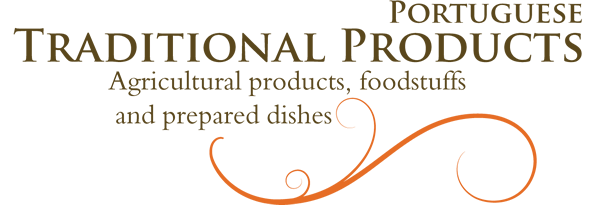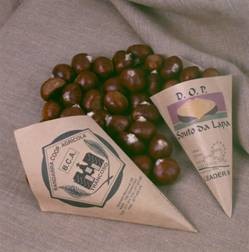Description: The Castanha dos Soutos da Lapa PDO is the fruit obtained from the chestnut tree (Castanea sativa Mill) of the Longal and Martaínha varieties. Batches must be homogeneous, that is to say, the nuts must be of the same origin, variety, quality, size and have substantially the same state of maturity or development.
Production method: The specific steps in production that must take place in the delimited geographical area are the production and harvesting of the fruit. The collection of the fruits is made from the ground and mechanical or manual methods can be used. The fruits are harvested by variety and put together in batches. As a guarantee of product homogeneity the difference in weight between the 10 smallest fruit and the 10 largest fruits of a 1 kg sample should not exceed 80 grams.
Special features: The Castanha dos Soutos da Lapa PDO is distinguished by the reddish brown color and very bright of the fruits of the cv Longal and light brown with average brightness of the fruits of the cv Martaínha. The taste of nuts is a very important qualitative aspect, especially for fresh consumption. Although very soft they are not too floury and have a characteristically light and very sweet palate.
Production area: The geographical area of production of Castanha dos Soutos da Lapa PDO is limited to f the municipalities of Armamar, Tarouca, Tabuaço, S. João da Pesqueira, Moimenta da Beira, Sernancelhe, Penedono, Lamego, Aguiar da Beira e Trancoso.
History: The history of Castanha dos Soutos da Lapa PDO is closely linked to the geographical area. The chestnut is one of the main trees that grow in this region, and its wood has always been applied in civil construction and handicrafts in activities such as basketwork and cooperage. The chestnut was even considered the "bread tree", so great was the importance it assumed in the economy, food habits and culture. Today, there are countless works on the subject, quotes from Portuguese authors (prose and verse) such as Gil Vicente and Aquilino Ribeiro. Its presence in the cuisine is marked through a multitude of dishes and options like puddings, cakes etc., being numerous the celebrations and fairs organized in the region where the chestnut always has a prominent place, like the Feast of S. Martinho common to all the municipalities, the Feast and the Chestnut Fair of S. Simão in Sernancelhe and Trancoso.
Product specification (pdf)
Producer group
Bandarra - Cooperativa Agrícola do Concelho de Trancoso, C. R. L.
Control and certification body
Kiwa Sativa – Unipessoal, Lda.
Control plan
Control plan (pdf)
Publication in EU official journal
Regulamento (CE) N.º 1107/96 da Comissão de 12.06.1996 – L 148/1
Publication in the Portuguese official journal
Aviso (extrato) n.º 204/2017, de 05.01.2017
Aviso (extrato) n.º 12301/2015, de 23.10.2015



